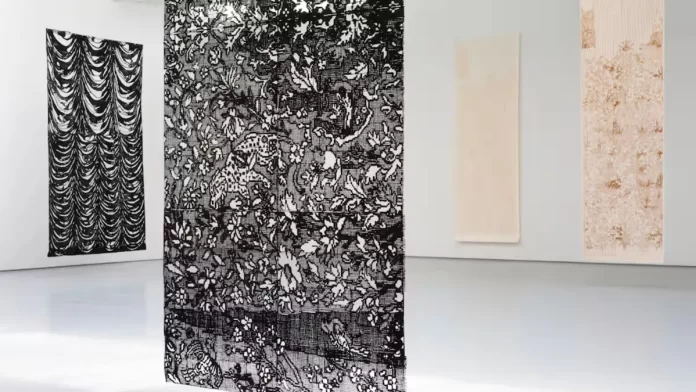
In her new exhibition at an arts centre in Scotland, Sukaina Kubba inserts herself into the lineage of rug weavers, transforming age-old floral and geometric design into fragile, rubbery latex matrices.
The Baghdad-born artist grew up in Abu Dhabi, studied in Montreal and now lives in Toronto. In between she was a lecturer and curator at the Glasgow School of Art in Scotland from 2013 to 2018 and has exhibited her work in Canada and the UK.
Her latest work, on display at Dundee Contemporary Arts, comes from a residency in the institute’s print studio, where she delved into Scotland’s history of rug making.
As industrialisation grew in the 1800s, a number of factories in Scotland turned to manufacturing rugs for a newly developing middle-class market as well as ocean liners, hotels, and new building projects across the country.
Their ability to machine-produce the carpets displaced the cottage industries of rug production in Iran, India and what is now Kurdish and federal Iraq. Yet many of the carpets still used Persian rugs as the basis of their design.
Factories such as Stoddard & Co and James Templeton & Co would send people down to the V & Museum in London, for instance, where they would trace Persian rugs in the museum collection. These watercolour tracings were then brought back to Scotland, where they were mass-produced and sold at cheaper cost.

Kubba’s research culminated in Turn Me Into a Flower, which she opened last week at Dundee Contemporary Arts, a non-profit centre in the Scottish city of Dundee. Kubba had been working with Tiffany Boyle, who recently took up the post as head of exhibitions in Dundee and put together Kubba’s exhibition as curator.
Echoing the process of transference, Kubba has retraced the designs from what is now the Stoddard Templeton collection, as well as rugs from her family and other types that she has become interested in. She has produced them in soft latex via 3D printing.
Unlike the way that these rugs have been produced for thousands of years, Kubba has taken out the human maker. Instead, she has brought computers into the mix, though even here she works to allow the technology to have a degree of control over the process. After uploading the design, she speeds up the 3D printing process so that the printer must try to withstand the new speed, creating glitches and random effects in the final product.
The results are eerie weaves that she hangs on the wall. They carry the un-naturalism of computer-generated work, as if an early iteration of the Matrix from the popular film had tried to produce woven carpets. There’s also a sense of fragility, with gaps in the soft filament showing through the bare bones designs.
“I’m interested in the process of the transformation of the image and the object,” says Kubba. “When they started making the rugs in Scotland, there was a sense of both transportation and transformation of these carpets. Now I’m taking these drawings and traces and transforming them again.”
Rugs as history
Kubba has been experimenting with the rug designs for a number of years, though this is the first direct research into the commercial workings of Victorian Scotland. Her fascination stems in part from the history of rugs as elements of migration – a craft form that began in the Middle East and subsequently travelled, as did her family, from East to West. The itinerancy, she notes, is embedded into the form of the rug itself, which is designed to be rolled up and easily transported.

But she also looks at rugs as storytellers. A few years ago Kubba grew obsessed, she says, by one particular type of Persian rug, called senneh, which are typically hand knotted and designed as they are produced, rather than worked from a template. Because of this organic method of production, their intricate floral designs often slip from the grid or contain mistakes.
“Sometimes I imagine that there are two or three women who made them,” she says, “And there’s bits of them that are quirky. It’s very hard to explain, but through remaking them I feel I understand the maker who created – say – the zig-zaggy squiggles that form the edges of the diamonds or the borders of the work. It’s an aesthetic choice, but it’s also the way someone’s hand works.”
For Kubba, the senneh designs reveal the stories of their making – much like her 3D printing technique introduces its own idiosyncrasy into the process.
The carpets also have their own hidden relation to industrialisation. Much like Victorian Scotland’s wealth derived from new means of production, Kubba also explores new techniques in manufacturing – taking the elements of 3D printing and working through what an artist might do with them.
She tried for a long time to create a drawing, she says, that one could pull off a wall – until a fellow artist told her about 3D pens, or pens that “write” in latex filament. It was by experimenting with these new materials that she realised what she was creating was new woven wall pieces – which only then led her to investigate the rugs that she had grown up with, in Abu Dhabi and Toronto. (One of the works not in the show is based on her brother’s carpet, which she remembers playing marbles on.)
But now she says, the works have returned despite themselves to the look and feel of textiles. “Even though the material is plasticky, they have an embroidered and woven feeling to them,” she says. “Some of them look like velvet – like they’ve started as a watercolour and a text and then been transformed back to something tactile and soft.”
Sukaina Kubba’s Turn Me Into a Flower runs at Dundee Contemporary Arts until August 4.
source: www.thenationalnews.com



